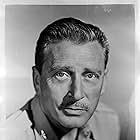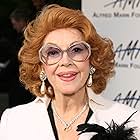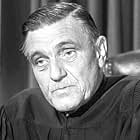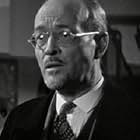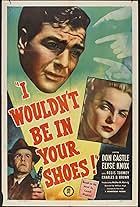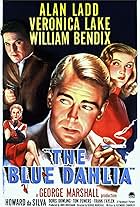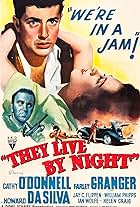IMDb RATING
6.5/10
6.5K
YOUR RATING
The female editor of a crime magazine hires Phillip Marlowe to find the wife of her boss. The private detective soon finds himself involved in murder.The female editor of a crime magazine hires Phillip Marlowe to find the wife of her boss. The private detective soon finds himself involved in murder.The female editor of a crime magazine hires Phillip Marlowe to find the wife of her boss. The private detective soon finds himself involved in murder.
Eddie Acuff
- Ed - Coroner
- (uncredited)
Charles Bradstreet
- Party Guest
- (uncredited)
David Cavendish
- Party Guest
- (uncredited)
Wheaton Chambers
- Property Clerk
- (uncredited)
Roger Cole
- Party Guest
- (uncredited)
Frank Dae
- Party Guest
- (uncredited)
- Director
- Writers
- All cast & crew
- Production, box office & more at IMDbPro
Storyline
Did you know
- TriviaLloyd Nolan was almost blinded when the glass splinters from a bullet that smashed a window hit him in the face. He was rushed to the hospital and a doctor carefully removed a shard of glass from the edge of his cornea.
- GoofsWhen Adrienne is taking care of Marlowe after the car crash, she hands him a mirror so he can see his injuries. As he's putting the mirror down, the face of a stage hand is reflected in the mirror.
- Quotes
Adrienne Fromsett: [to Marlowe] Perhaps you'd better go home and play with your fingerprint collection.
- Crazy creditsSPOILER! In the opening credits Chrystal Kingsby is written as being played by Ellay Mort, the phonetic spelling for 'elle est morte', French for 'she is dead.'
- Alternate versionsThere is an Italian edition of this film on DVD, distributed by DNA srl, "UNA DONNA NEL LAGO (1947) + L'UOMO NELL'OMBRA (1952)" (2 Films on a single DVD), re-edited with the contribution of film historian Riccardo Cusin. This version is also available for streaming on some platforms.
- ConnectionsFeatured in The Best of Film Noir (1999)
- SoundtracksJingle Bells
(uncredited)
Written by James Pierpont
Played during the opening credits
Also sung at the office Christmas party
Featured review
For a suspense writer whose observations of mid-20th-century Los Angeles proved so gimlet-eyed that he has been enshrined as the city's unofficial bard, Raymond Chandler had a bumpy fling with Hollywood. The first of his five major novels to be filmed during the classic period of film noir, Farewell, My Lovely was first turned into an installment in the Falcon series of programmers, then into Edward Dmytryk's 1944 Murder, My Sweet (a success, but too short; to do justice to Chandler's atmospherics and milieu demands longer time spans than the movies allot them).
From 1946, probably the most adroit blending of style and content taken from his works was Howard Hawks' The Big Sleep. But its popularity, then and now, owes as much to the chemistry between Humphrey Bogart and Lauren Bacall and to the frisky, irreverent tone Hawks brought to the movie as to Chandler, whose outlook was one of dispassionate observation tinged with disgust.
The following year, The Brasher Doubloon, from the book The High Window, can be deemed a failure. That leaves the odd case of The Lady in the Lake, also from 47, which Robert Montgomery, starring as Philip Marlowe, ill-advisedly decided to direct himself. The movie labors under two huge handicaps: one of technique, the other of tone.
Cited often (and often by those who may not have actually seen the movie) for its subjective use of the-camera-as-character, The Lady in The Lake flounders on an idea that may have sounded good when initially floated but had to have looked bad once the first rushes came in.
Except for an explanatory prologue (the necessity for which should have raised red flags) or in scenes where he's caught in a window or mirror, Montgomery's Marlowe remains unseen. We, through the camera lens, are the detective. Conceivably, this gimmick might have worked at a later date, when swift, lithe Steadicams were part of Hollywood's technical arsenal. But in1947, the camera lumbers along as though it were being shoved through wet sand. As a result the pace slows to deadening, as though a senescent Marlowe were tracking down clues from the rail of an aluminum walker.
In consequence, time that might profitably been expended on filling in missing pieces of the puzzle gets wasted on Marlowe's getting from point A to point B. Vital and evocative parts of Chandler's novel take place in the summer resort areas of Puma Point and Little Fawn Lake; that snail of a camera, however, was not up to a hike in the great outdoors, so the movie preserves none of them.
And in tossing away chunks of the novels to accommodate budgets and shooting schedules, movie versions (like this one) mistake Chandler's strengths, which did not lay in plot. (The scriptwriters on The Big Sleep, including William Faulkner, couldn't figure out who killed one of the characters, so they asked Chandler, who didn't know either.)
His strengths were in weaving intricate webs of duplicity and deceit shot through with corruption and dread. That was heavy fare for Hollywood even during the noir cycle. So stories tended to be simplified and atmosphere lightened: the freighted response gave way to the wisecrack, suggestive tension between two characters turned into a meet-cute, the brooding loner became a red-blooded American joe.
So, in The Lady in The Lake, the icy and questionable Adrienne Fromsett of the book (Audrey Totter) is now a sassy minx to Marlowe's snappy man-about-town, and so on. The plot deals with Marlowe's attempts to find a missing woman (an off-screen character whom the Christmas-card credits, in a droll fit of Francophone humor, call Ellay Mort).
Is a verdict possible? Some viewers find the movie's conceits and distortions amateurish and self-congratulating, while others overlook them to find a vintage mystery from postwar vaults. The Lady in The Lake remains a flawed experiment that over the years has developed its own distinctive if not quite distinguished period bouquet.
From 1946, probably the most adroit blending of style and content taken from his works was Howard Hawks' The Big Sleep. But its popularity, then and now, owes as much to the chemistry between Humphrey Bogart and Lauren Bacall and to the frisky, irreverent tone Hawks brought to the movie as to Chandler, whose outlook was one of dispassionate observation tinged with disgust.
The following year, The Brasher Doubloon, from the book The High Window, can be deemed a failure. That leaves the odd case of The Lady in the Lake, also from 47, which Robert Montgomery, starring as Philip Marlowe, ill-advisedly decided to direct himself. The movie labors under two huge handicaps: one of technique, the other of tone.
Cited often (and often by those who may not have actually seen the movie) for its subjective use of the-camera-as-character, The Lady in The Lake flounders on an idea that may have sounded good when initially floated but had to have looked bad once the first rushes came in.
Except for an explanatory prologue (the necessity for which should have raised red flags) or in scenes where he's caught in a window or mirror, Montgomery's Marlowe remains unseen. We, through the camera lens, are the detective. Conceivably, this gimmick might have worked at a later date, when swift, lithe Steadicams were part of Hollywood's technical arsenal. But in1947, the camera lumbers along as though it were being shoved through wet sand. As a result the pace slows to deadening, as though a senescent Marlowe were tracking down clues from the rail of an aluminum walker.
In consequence, time that might profitably been expended on filling in missing pieces of the puzzle gets wasted on Marlowe's getting from point A to point B. Vital and evocative parts of Chandler's novel take place in the summer resort areas of Puma Point and Little Fawn Lake; that snail of a camera, however, was not up to a hike in the great outdoors, so the movie preserves none of them.
And in tossing away chunks of the novels to accommodate budgets and shooting schedules, movie versions (like this one) mistake Chandler's strengths, which did not lay in plot. (The scriptwriters on The Big Sleep, including William Faulkner, couldn't figure out who killed one of the characters, so they asked Chandler, who didn't know either.)
His strengths were in weaving intricate webs of duplicity and deceit shot through with corruption and dread. That was heavy fare for Hollywood even during the noir cycle. So stories tended to be simplified and atmosphere lightened: the freighted response gave way to the wisecrack, suggestive tension between two characters turned into a meet-cute, the brooding loner became a red-blooded American joe.
So, in The Lady in The Lake, the icy and questionable Adrienne Fromsett of the book (Audrey Totter) is now a sassy minx to Marlowe's snappy man-about-town, and so on. The plot deals with Marlowe's attempts to find a missing woman (an off-screen character whom the Christmas-card credits, in a droll fit of Francophone humor, call Ellay Mort).
Is a verdict possible? Some viewers find the movie's conceits and distortions amateurish and self-congratulating, while others overlook them to find a vintage mystery from postwar vaults. The Lady in The Lake remains a flawed experiment that over the years has developed its own distinctive if not quite distinguished period bouquet.
- How long is Lady in the Lake?Powered by Alexa
Details
Box office
- Budget
- $1,026,000 (estimated)
- Runtime1 hour 45 minutes
- Color
- Aspect ratio
- 1.37 : 1
Contribute to this page
Suggest an edit or add missing content















